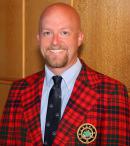Like father, like son.
Thirty-one years ago, Coloradan Dick Phelps became president of the American Society of Golf Course Architects, an organization which dates back to 1946.
Earlier this month, appropriately in Colorado, Dick’s son Rick Phelps assumed the presidency of the same trade group, which now includes about 170 members.
Dick and Rick Phelps thus became one of a handful of fathers and sons who have each served as the leader of the ASGCA, with the most famous being from the Jones family (Robert Trent and sons Rees and Robert Trent Jr.). Other past presidents include such notables as Pete Dye, Arthur Hills and Jay Morrish.
“Dad introduced me (at the recent ASGCA annual meeting in Westminster), and it was a fun, emotional evening,” said Rick Phelps, who owns Evergreen-based Phelps-Atkinson Golf Course Design. “It was obviously a very special evening for me, and it meant a lot to my dad too.”
 Fittingly, Rick hearkens back to his dad’s heyday as a golf course architect when he speaks about what will be his main area of emphasis during his year or so as ASGCA president.
Fittingly, Rick hearkens back to his dad’s heyday as a golf course architect when he speaks about what will be his main area of emphasis during his year or so as ASGCA president.
“The biggest thing growing up with dad was he worked his way into a niche of (designing) affordable public courses (especially in Colorado, such as Foothills and Indian Tree),” Rick said. “He almost established a new market for himself — public golf at reasonable rates. My deal as president is to point out that the golf industry needs those kinds of facilities.”
Noting that in recent decades an emphasis was placed on opening very challenging courses that draw attention on “best-of” lists put together by national golf publications, Phelps believes layouts that are both affordable and enjoyable for average golfers often are given short shrift.
“If all the golf course supply in the U.S. were stacked up like a pyramid, the affordable facilities would make up the base,” he said. “But now we’re building too many on top without having the support below. So we need to build up the base again. That’s my main push — to get that story out. The average golfer — maybe toward the beginner level — doesn’t need the challenge of Blackstone and Murphy Creek (golf courses) when they’d have just as much fun at a place like South Suburban.”
Lake his dad”˜s work, many of Rick Phelps’ designs in Colorado fall into the affordable public golf category. Among the 44-year-old’s credits are The Broadlands in Broomfield, Antler Creek in Falcon, Devil’s Thumb in Delta, South Suburban’s Family Sports in Centennial, the Creek 9 at Kennedy in Denver and the Silo 9 at West Woods in Arvada.
But, like many others in the golf industry, course architects are enduring challenging times with the glut of courses, and the economy being what it is. Very few new golf courses are opening in the U.S. these days, and in fact more courses are closing than opening. The National Golf Foundation projects that between 2010 and 2020 there will be a net decrease of 500-1,000 courses in the country.
The problem is that while the number of golfers in the U.S. declined slightly from 1990 to 2009, according to the NGF, more than 100 new courses opened in Colorado during that period, according to CGA records. So it’s no wonder why new construction has now virtually reached a standstill domestically.
“It’s obviously challenging for each of us individually,” Phelps said of the very competitive business of golf course design in America. “There’s so little work and jobs out there. China and Korea are the only places where new construction is strong. For our Society, the effect has yet to be seen. We haven’t lost that many members. Some are hanging on by doing renovation projects. It shows you how passionate we are about our profession that in some cases we’re willing to sacrifice family finances. Thank goodness many of our spouses work.”
Phelps said that five to seven years ago his firm did 70 percent new construction and 30 percent renovations. Now 80 percent of the work is renovations. Currently, Phelps-Atkinson is doing anything from work on a single bunker for one course to an extensive renovation at another.
While he believes business will bounce back some, Phelps said he greatly doubts it will ever return to the go-go days from 1982-2002. “We will probably never see that again in our lifetime.”
A big part of what the ASGCA has done in recent years is devoted to educating the public about not only the economic value of golf courses to communities, but how they’re part of the social fabric of those communities and how they play key environmental and open-space roles.
“The reality is, we are a tiny organization of about 170 compared to the PGA or the Golf Course Superintendents,” Phelps said. “For our size, we have a relatively loud voice, but we can’t do a significant marketing campaign. Instead, we work closely with allied associations and participate in their meetings and help steer the game in the right direction.”


